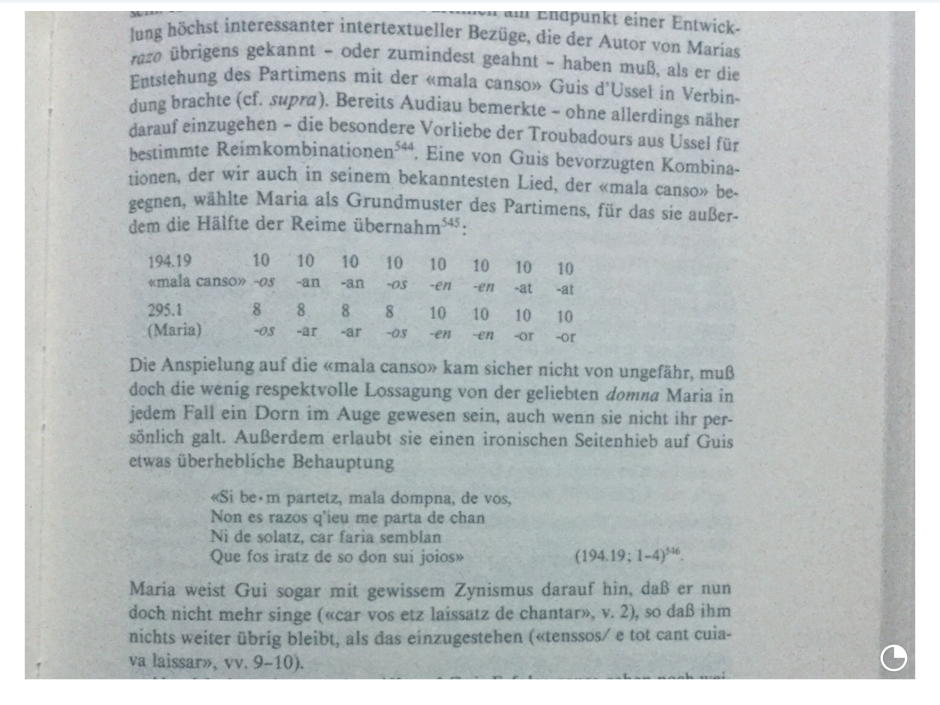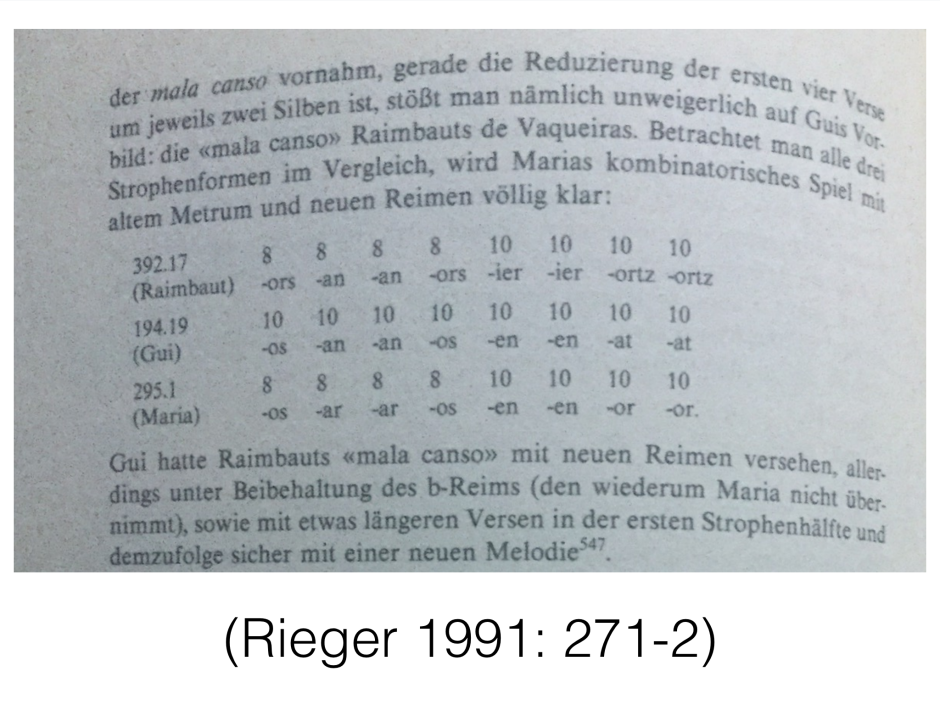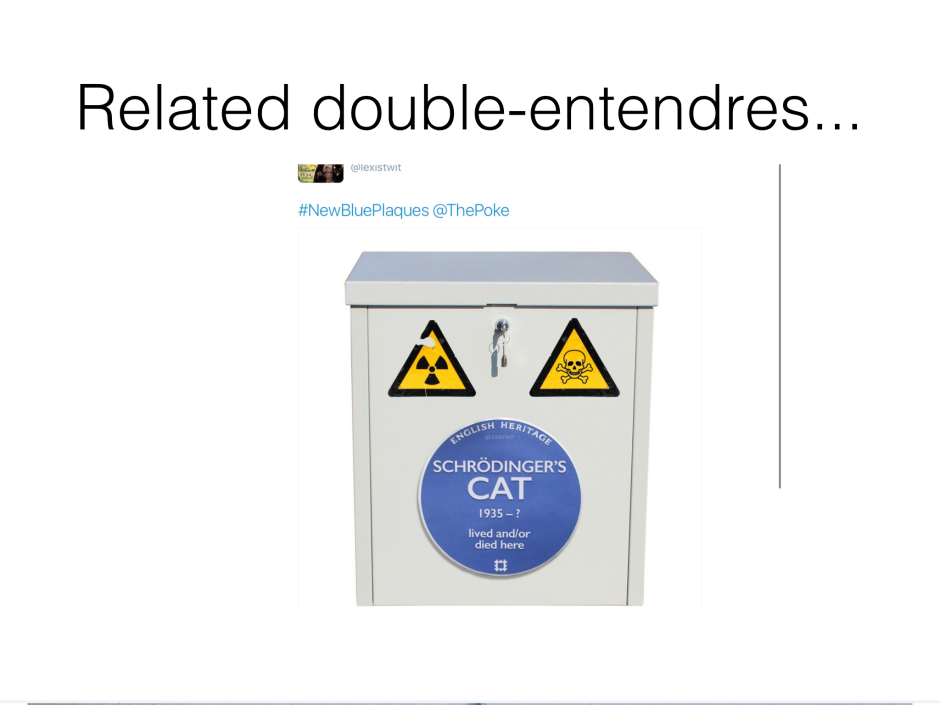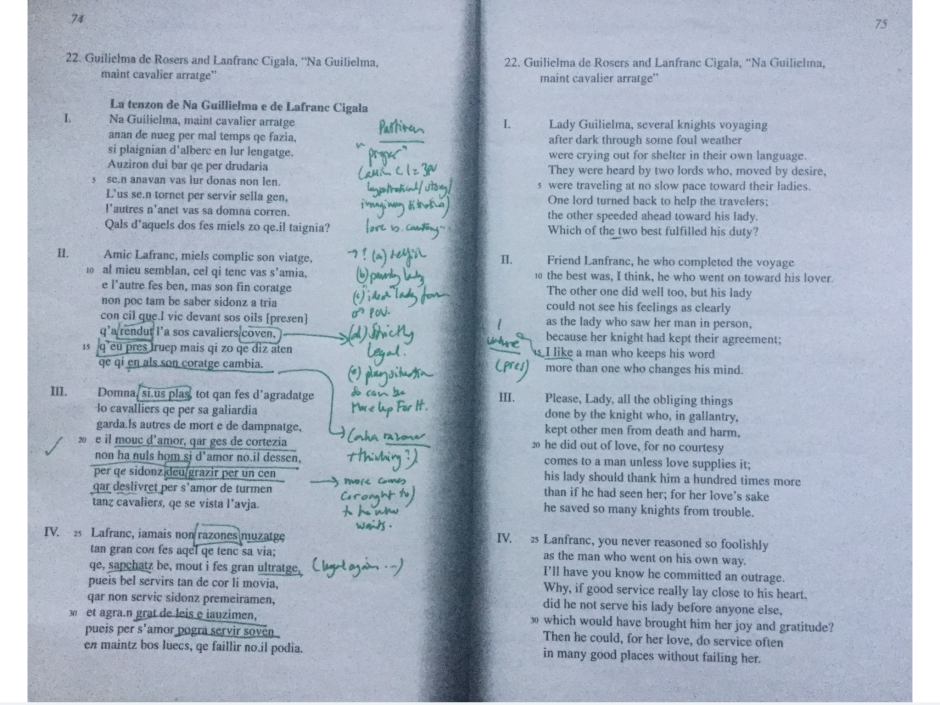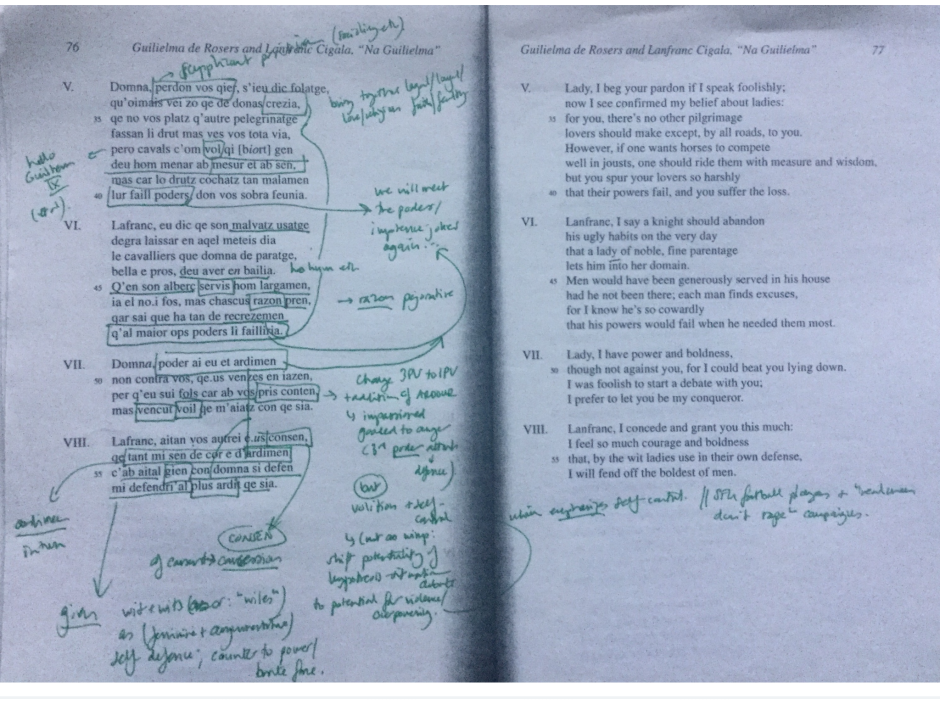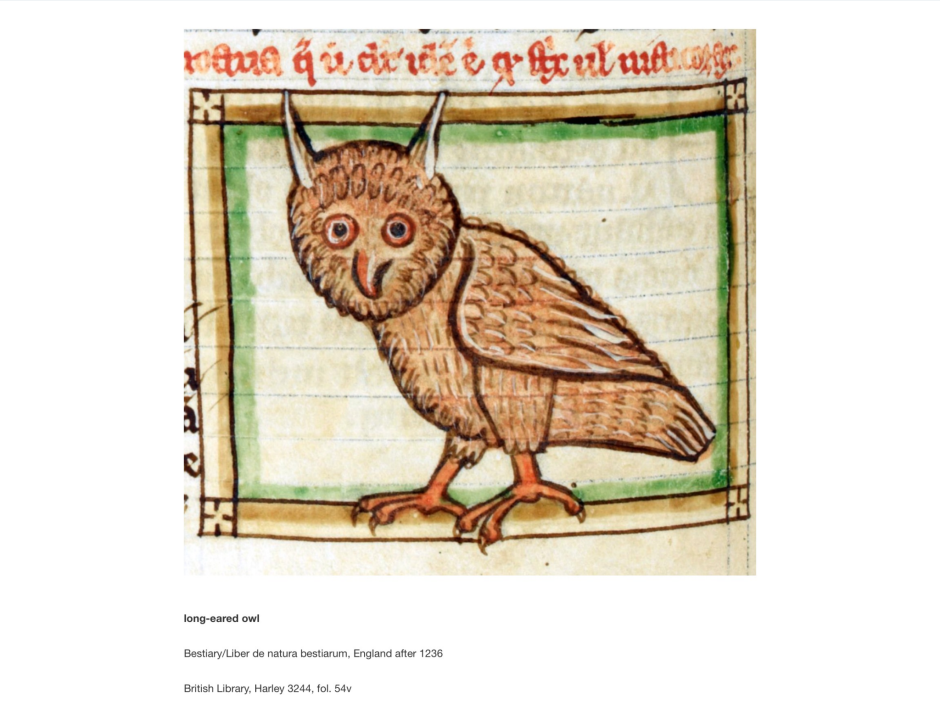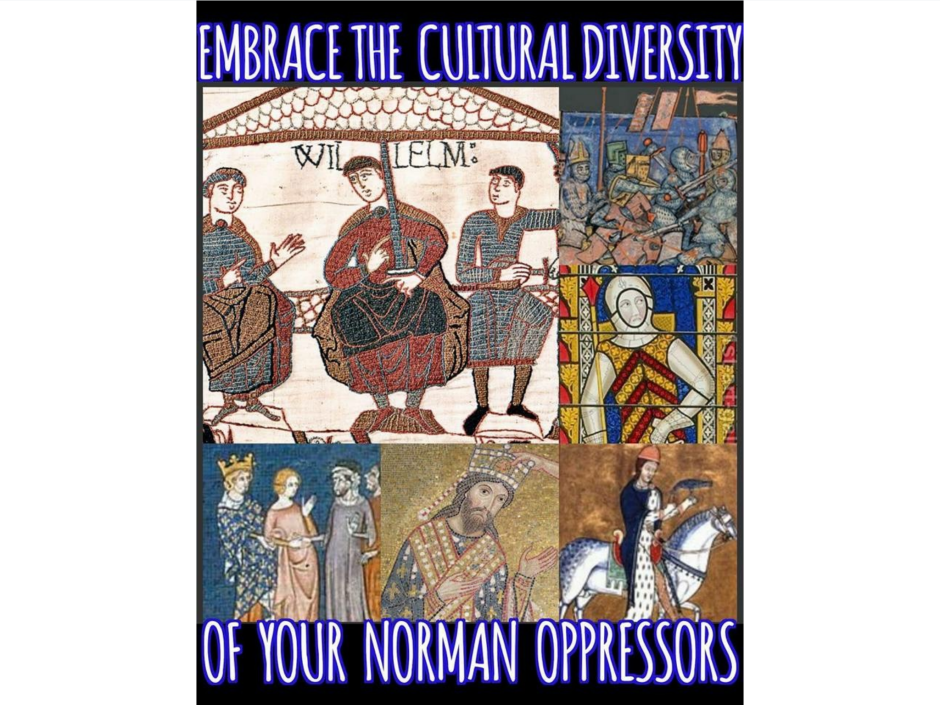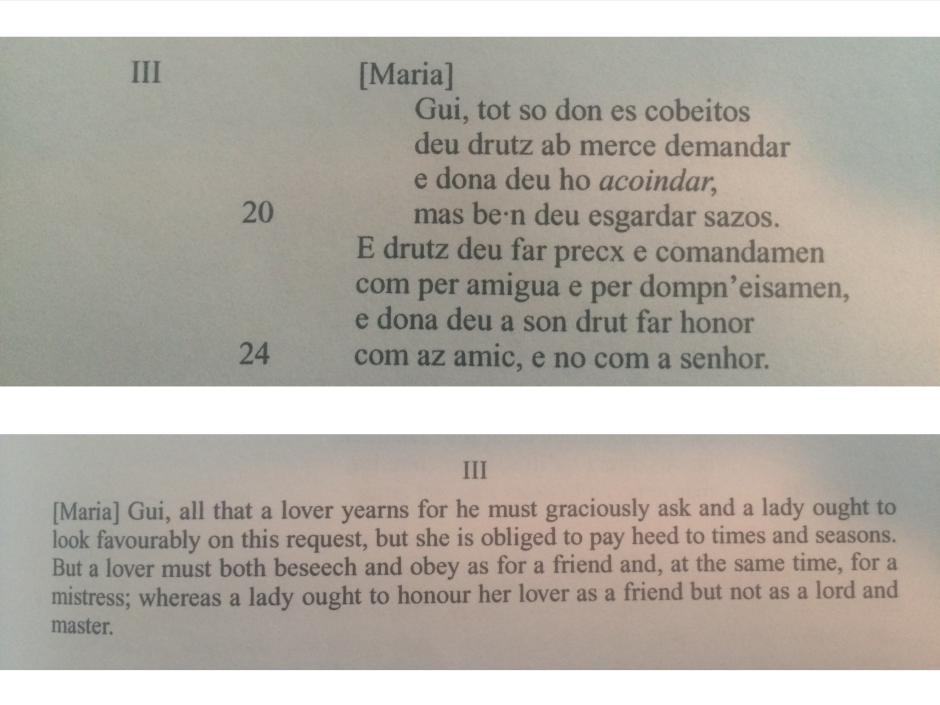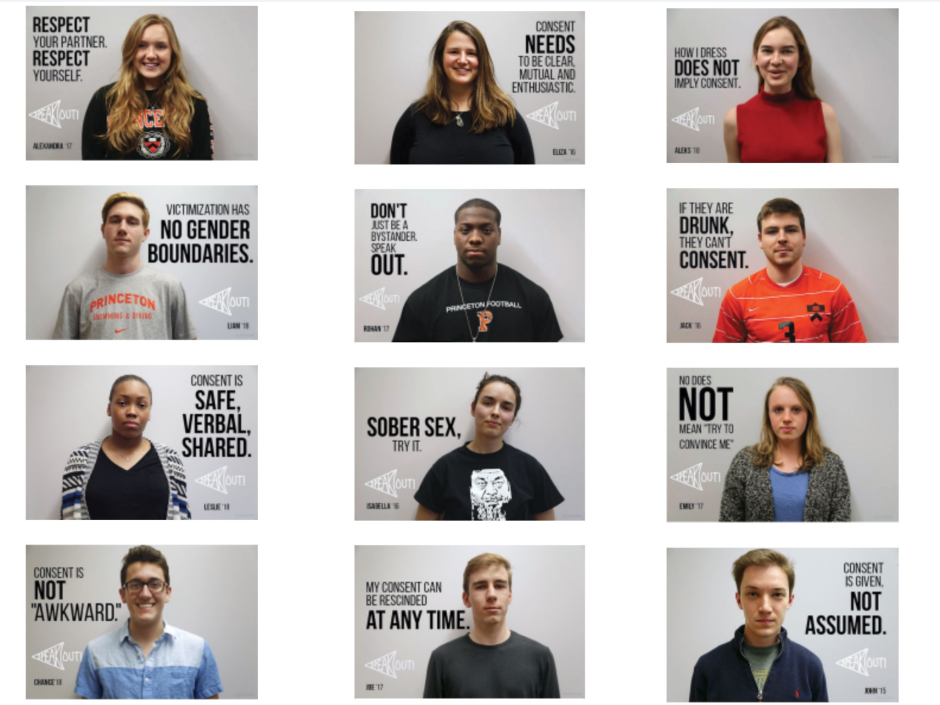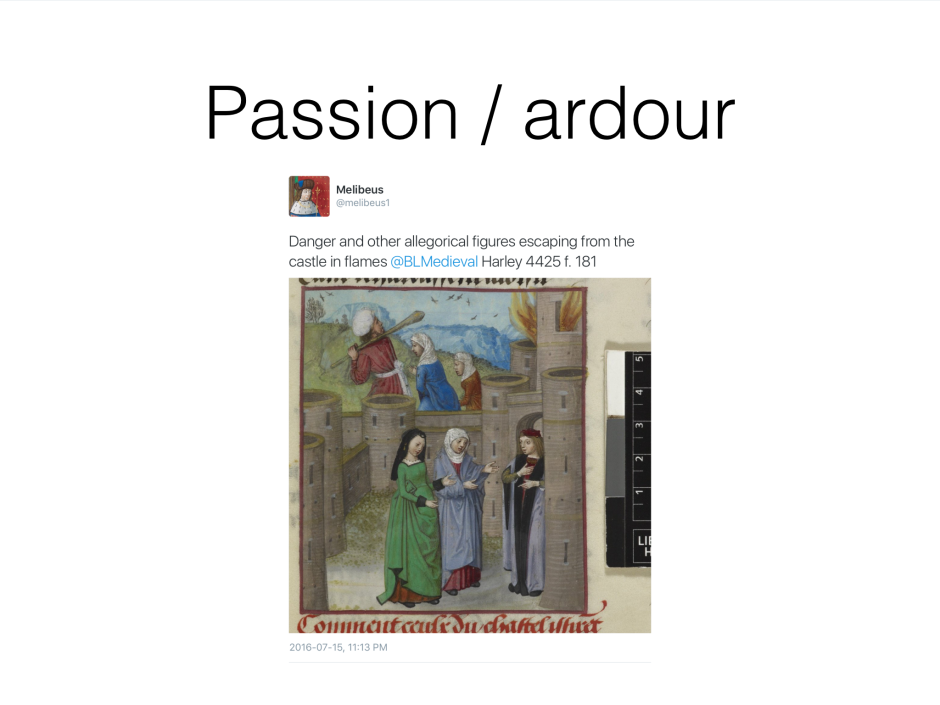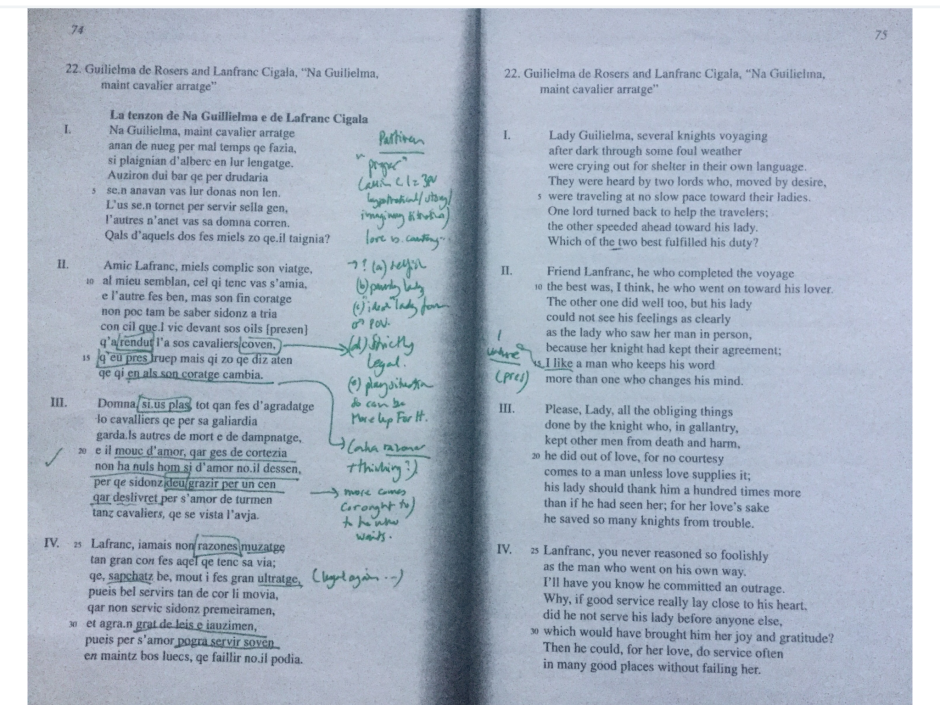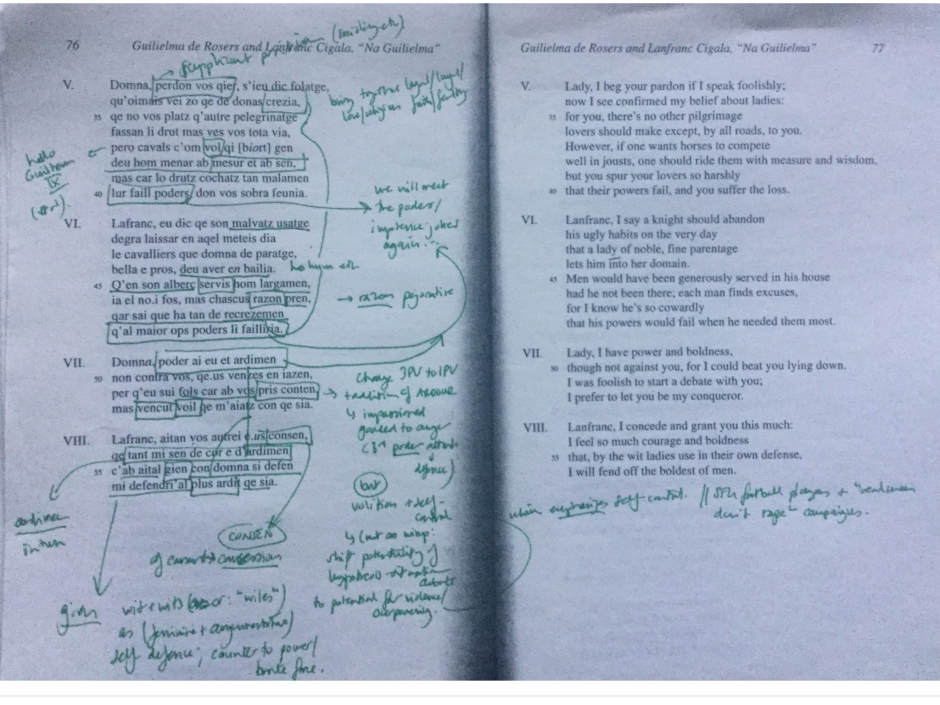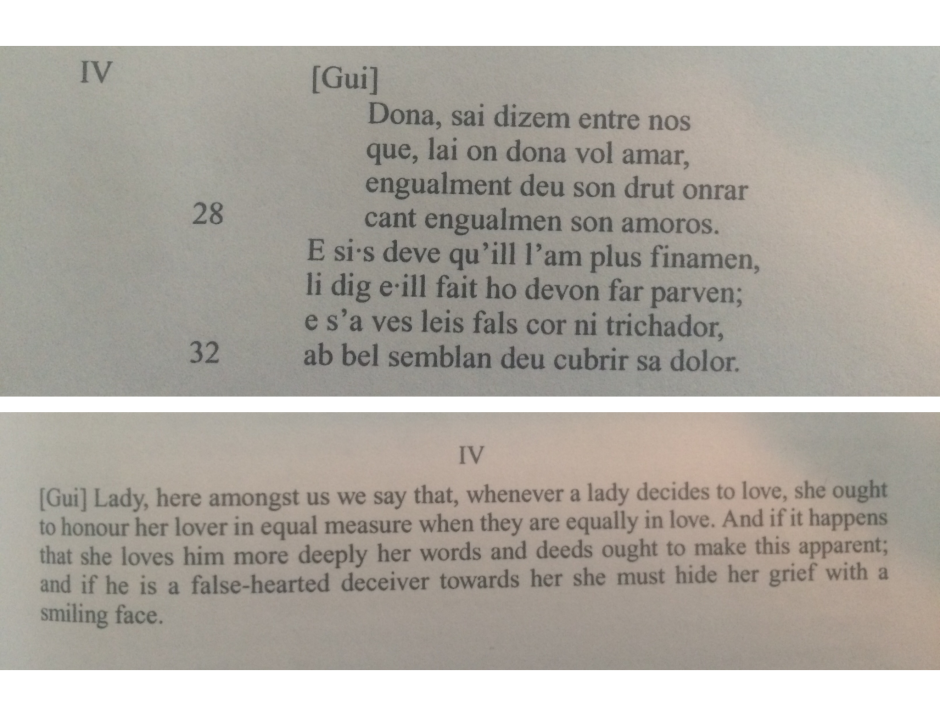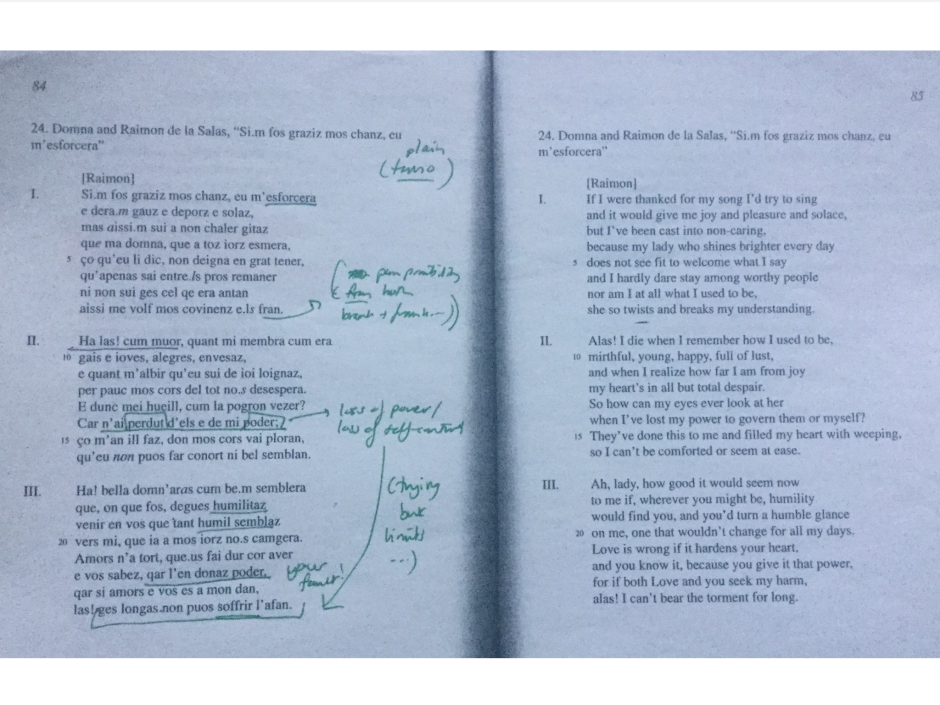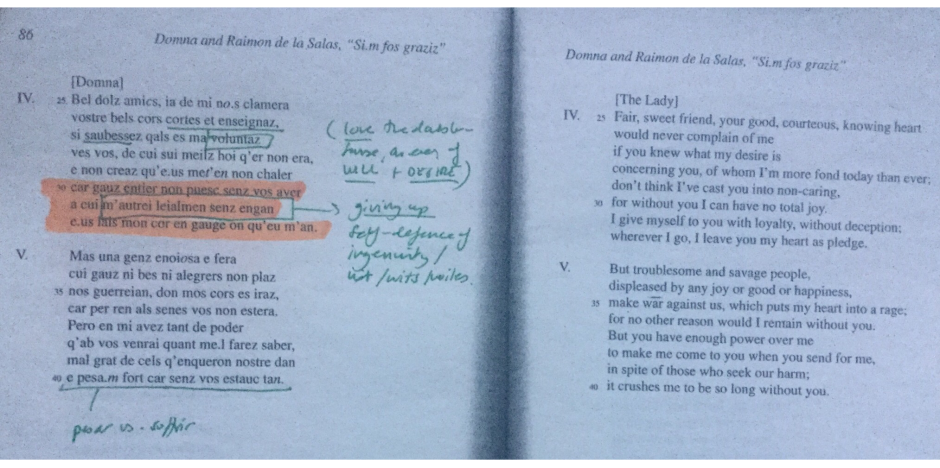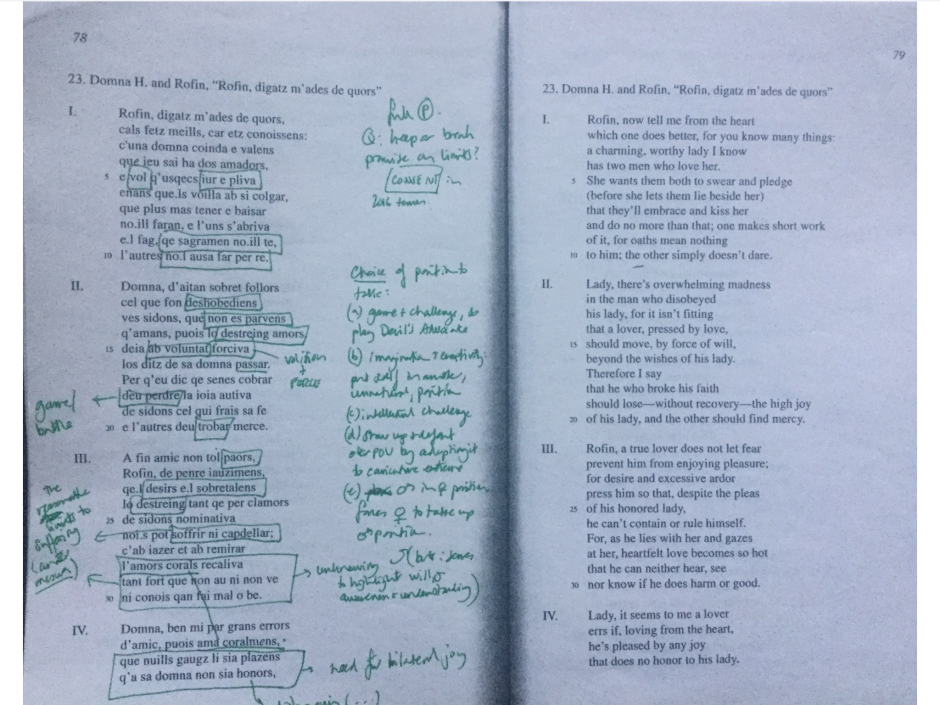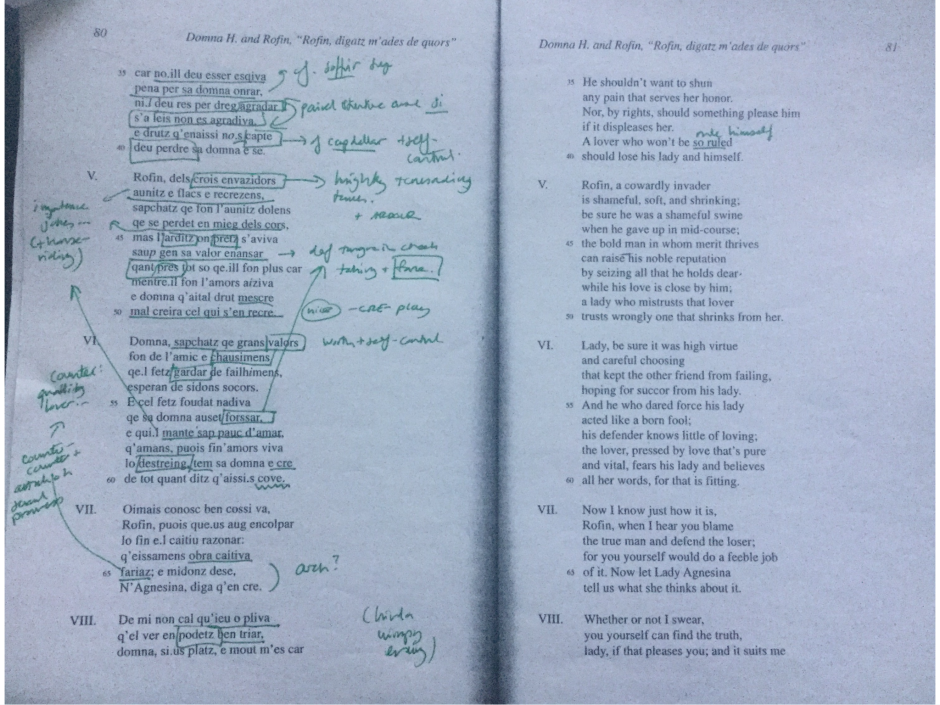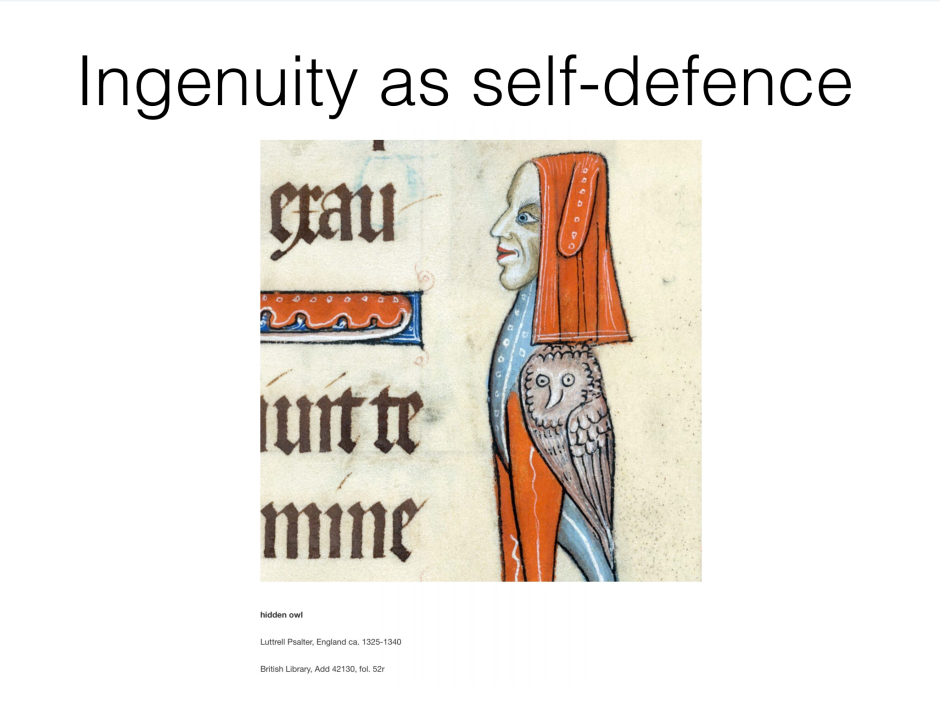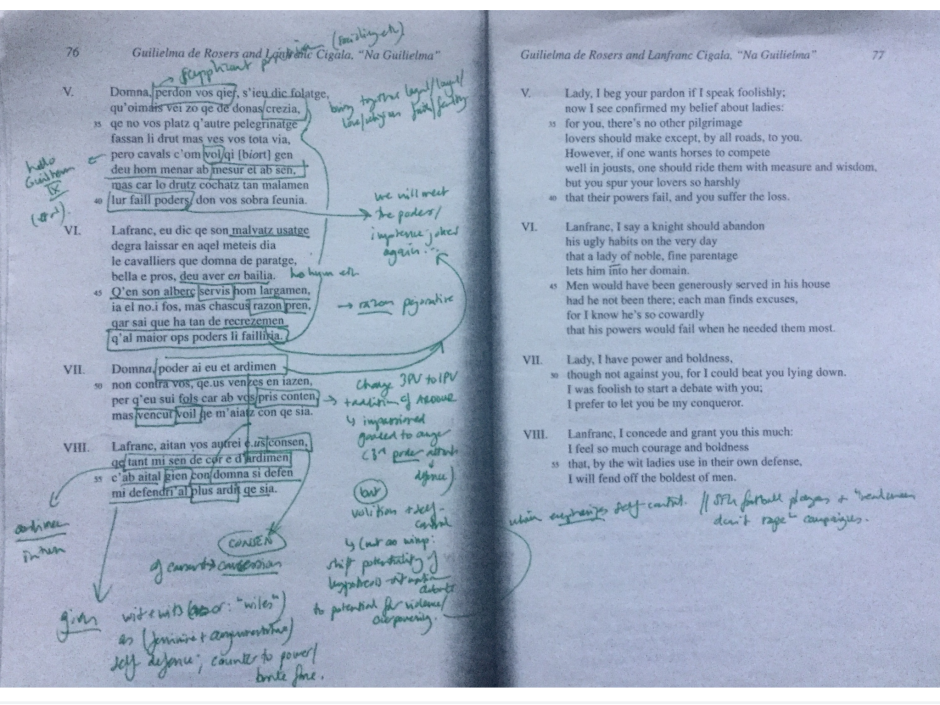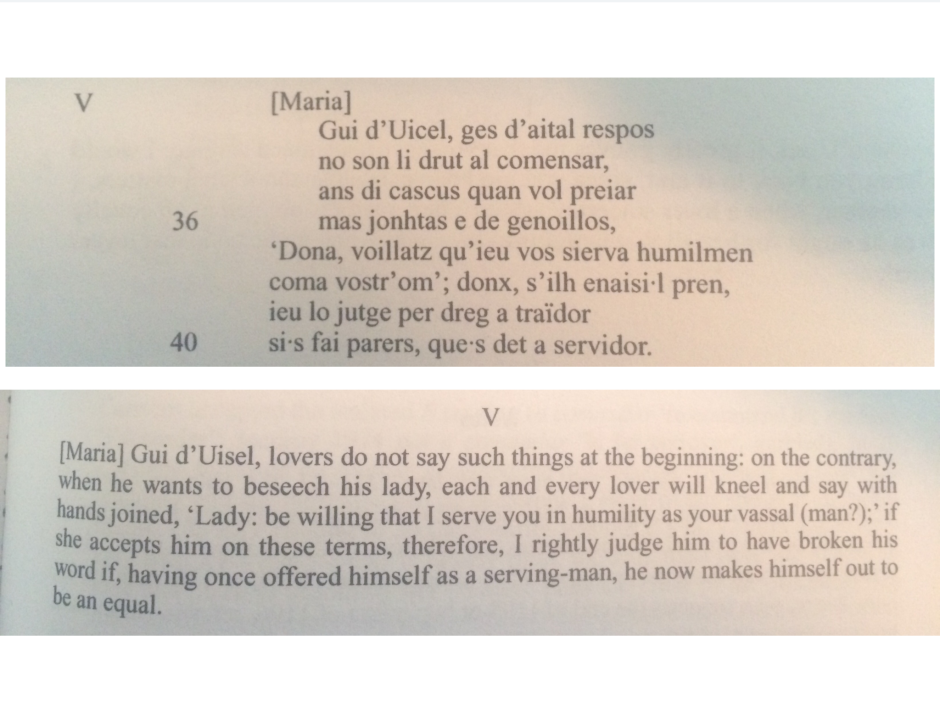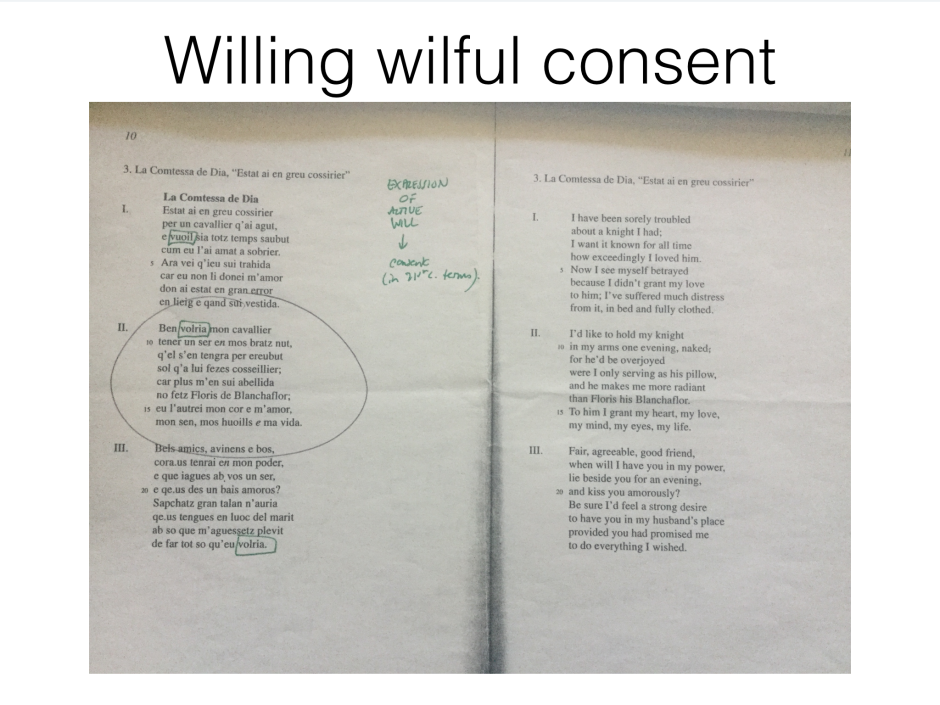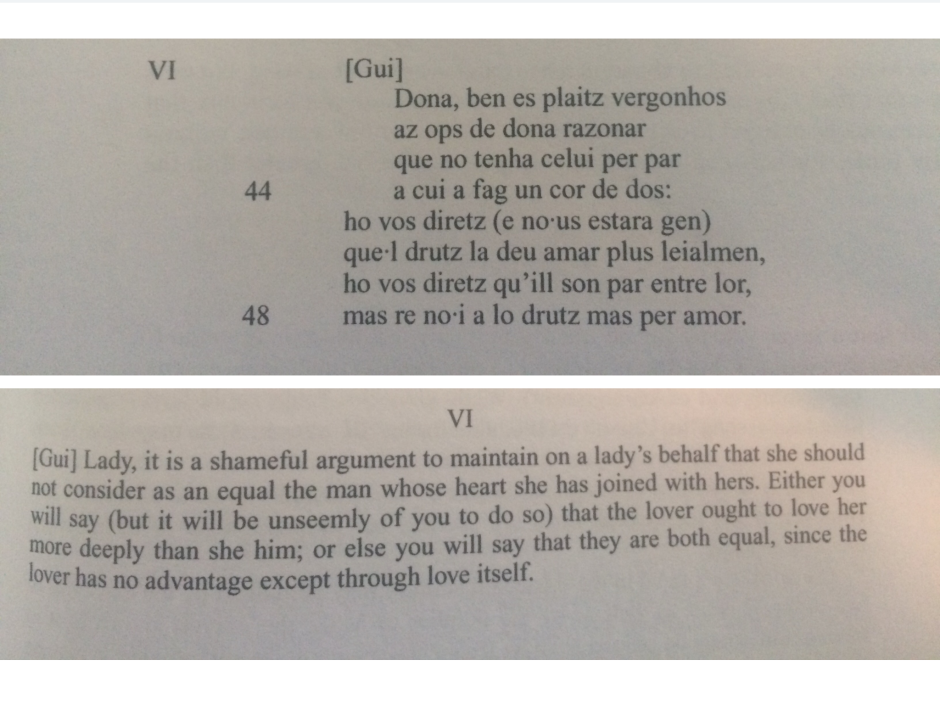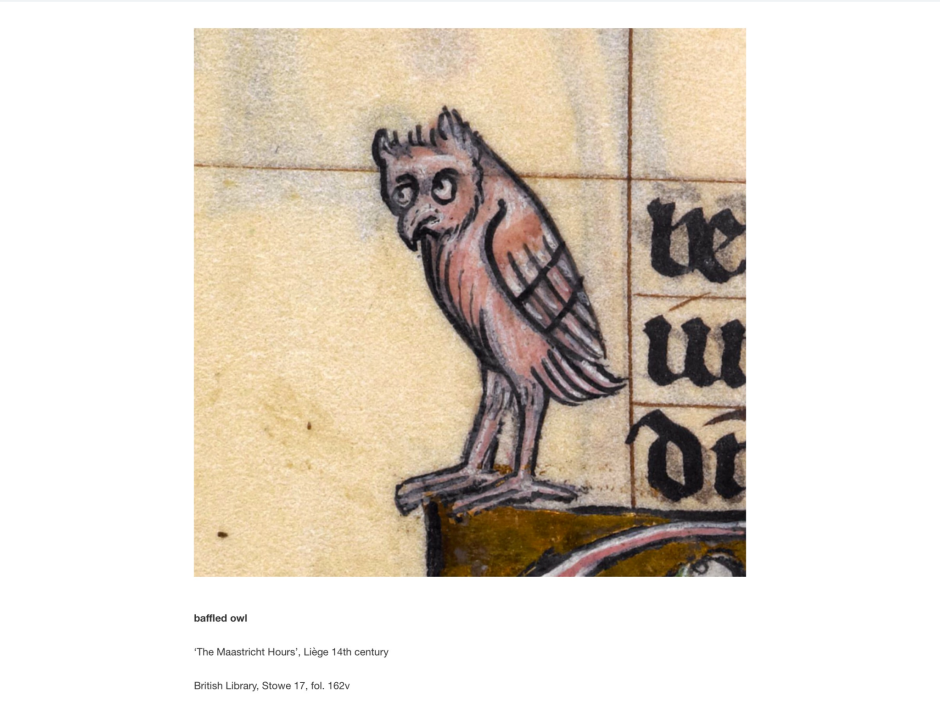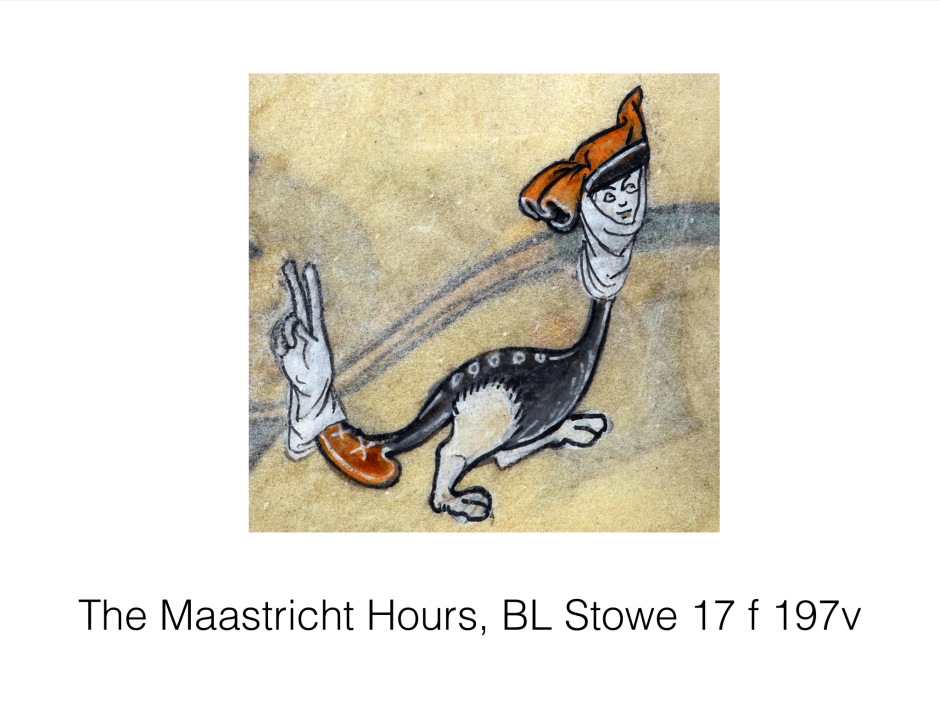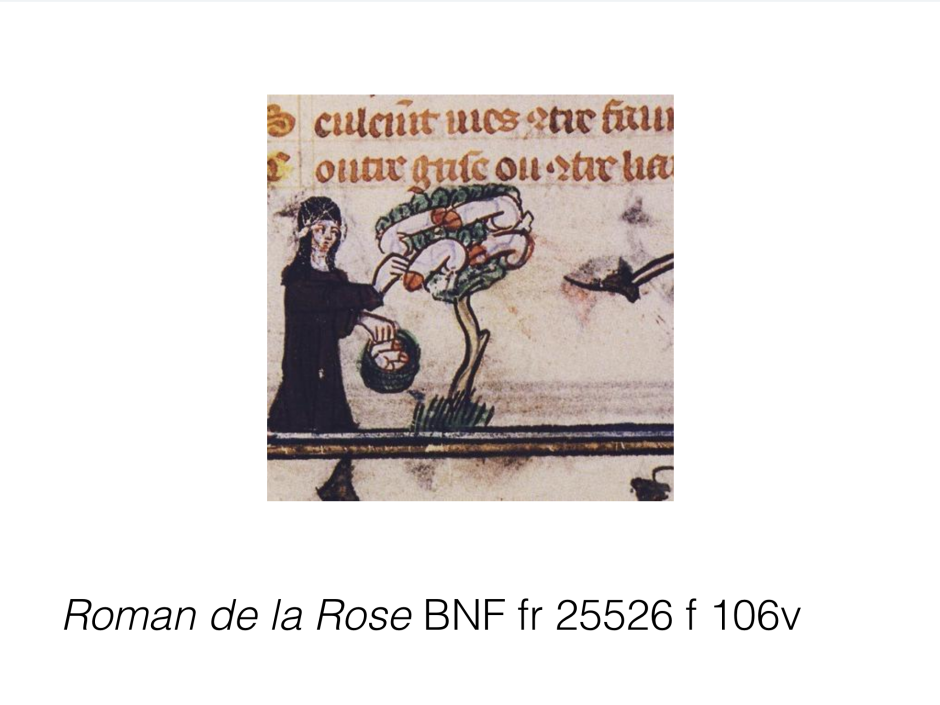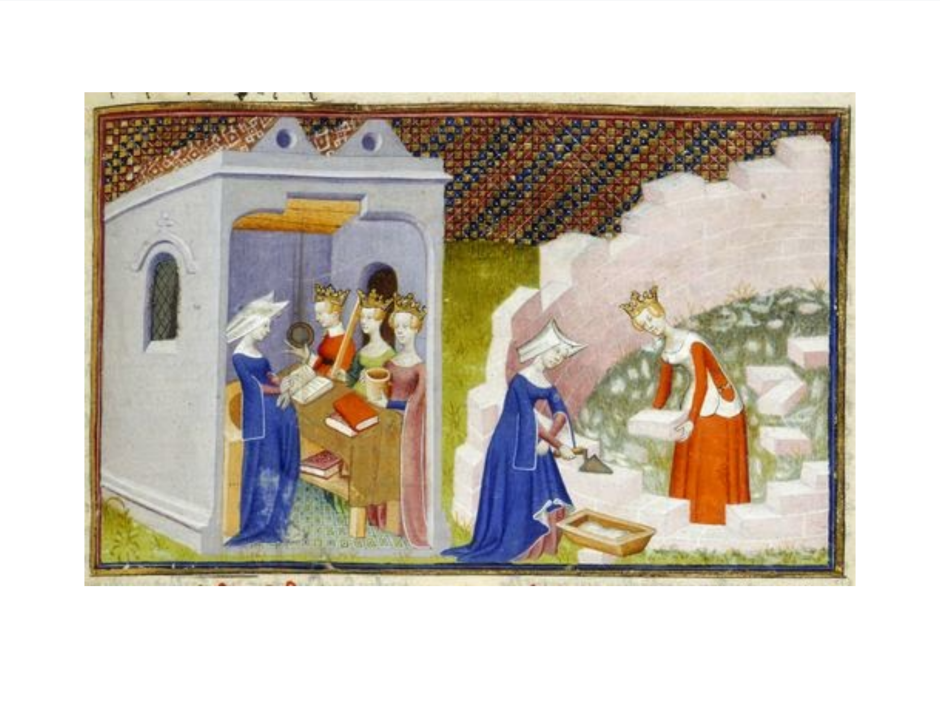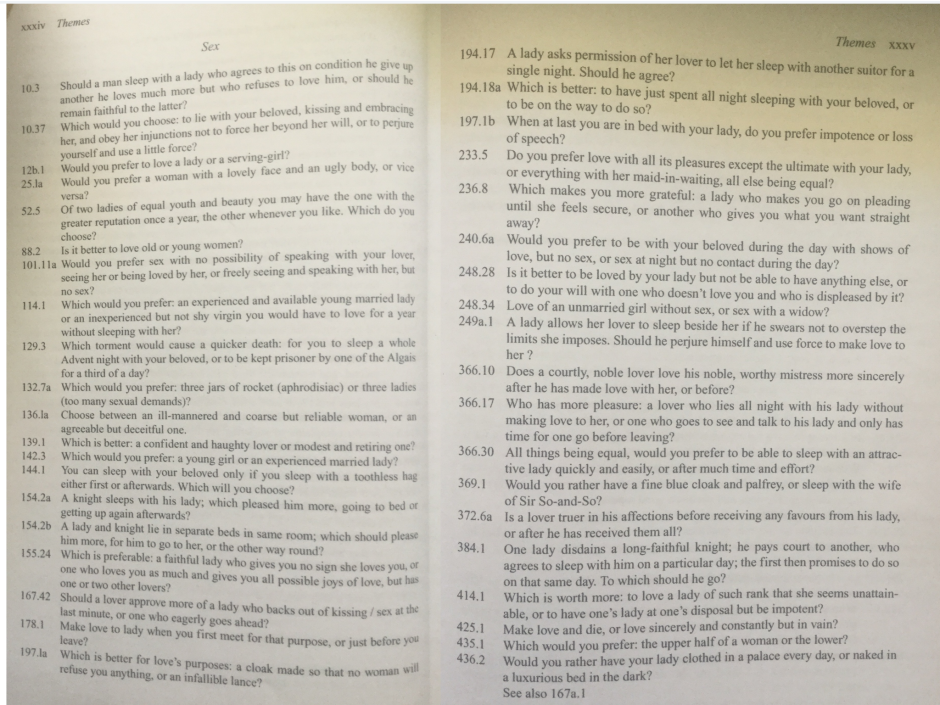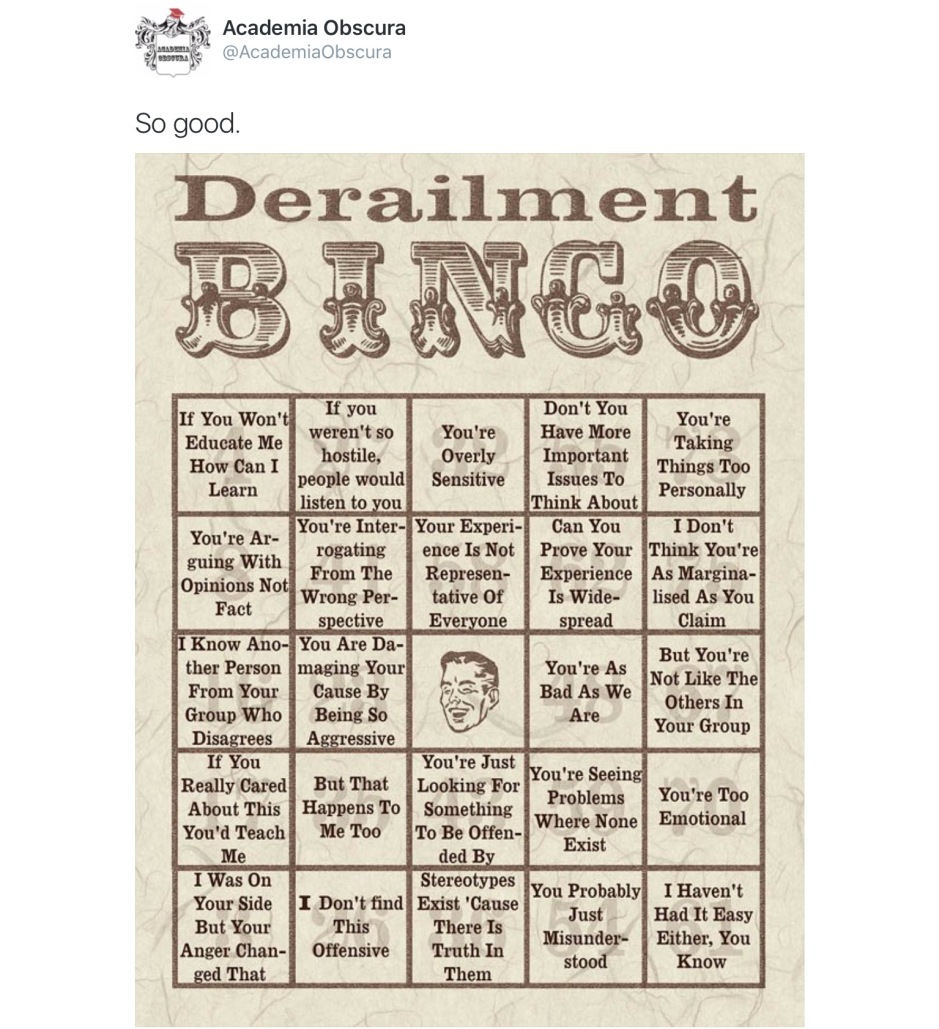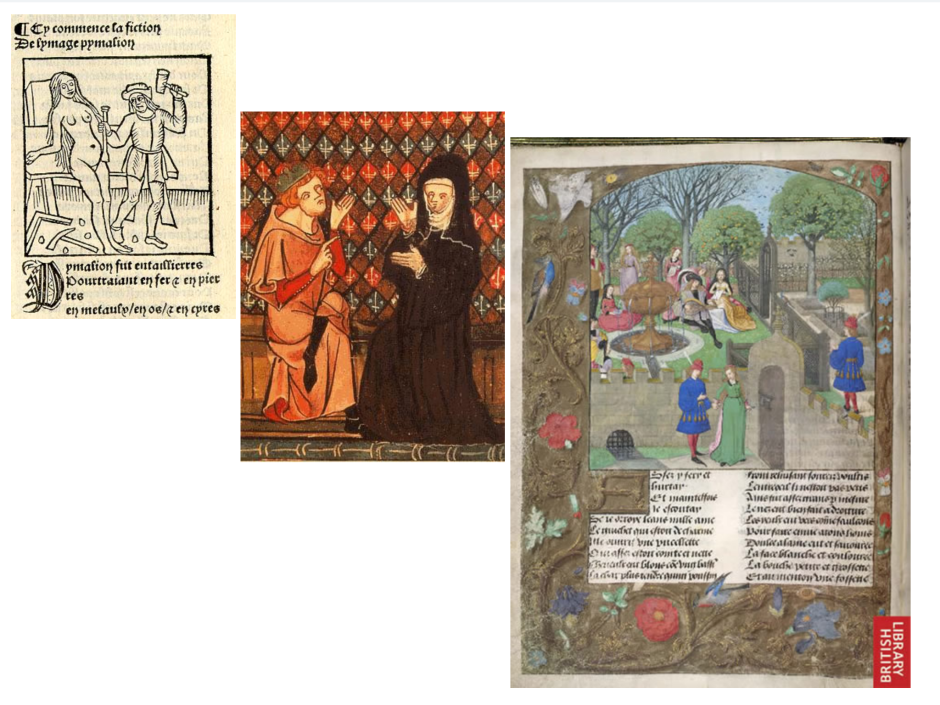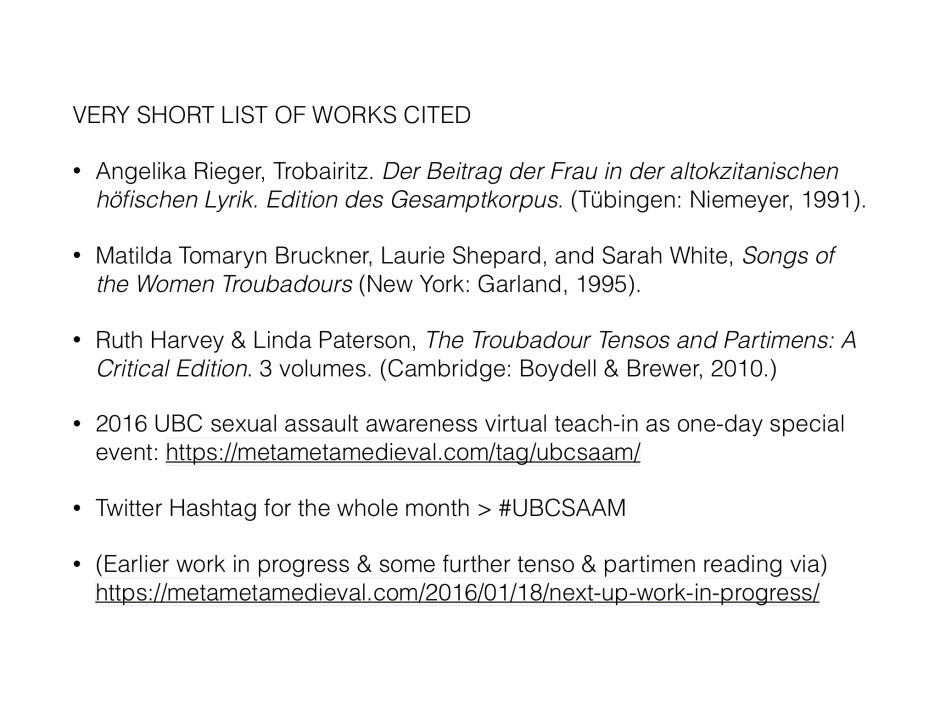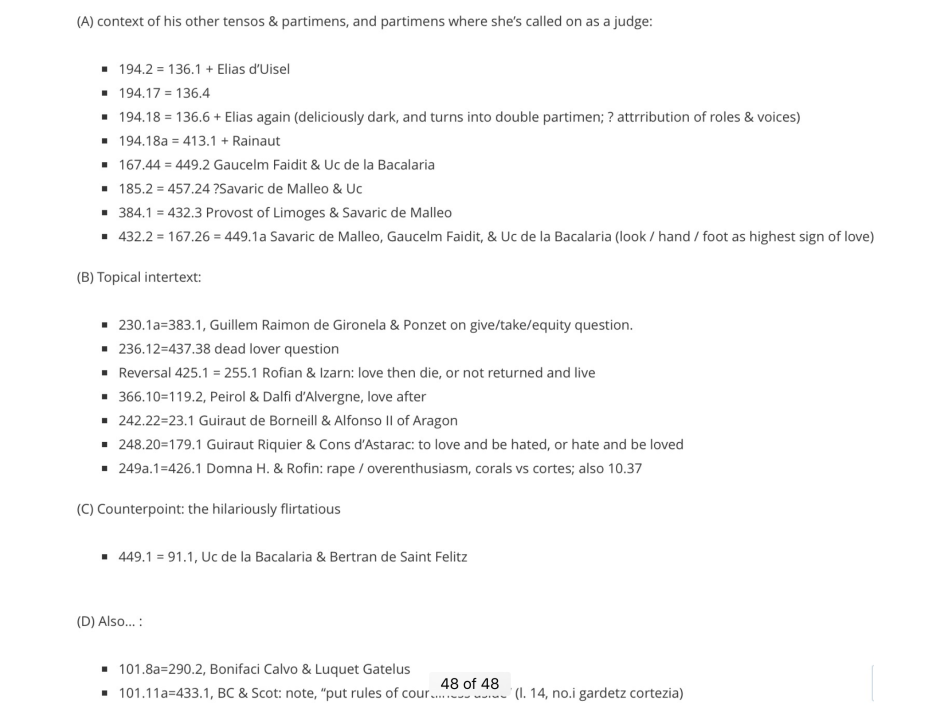Full version of a talk given at the 15th Triennial Congress of the International Courtly Literature Society; University of Kentucky, Lexington; 24-29 July 2016 (some parts cut or expanded on the fly, as is usual for live talks).
It includes a selection of medieval Occitan poetry (with Englishings) that might be interesting and perhaps even useful to general readers, feminists, anti-rape activists, paranomasiacs, comedians, and assorted other 21st century live human beings (and any other intelligences not covered above).
There are also pictures.
Including, as promised to a certain amic, owls.

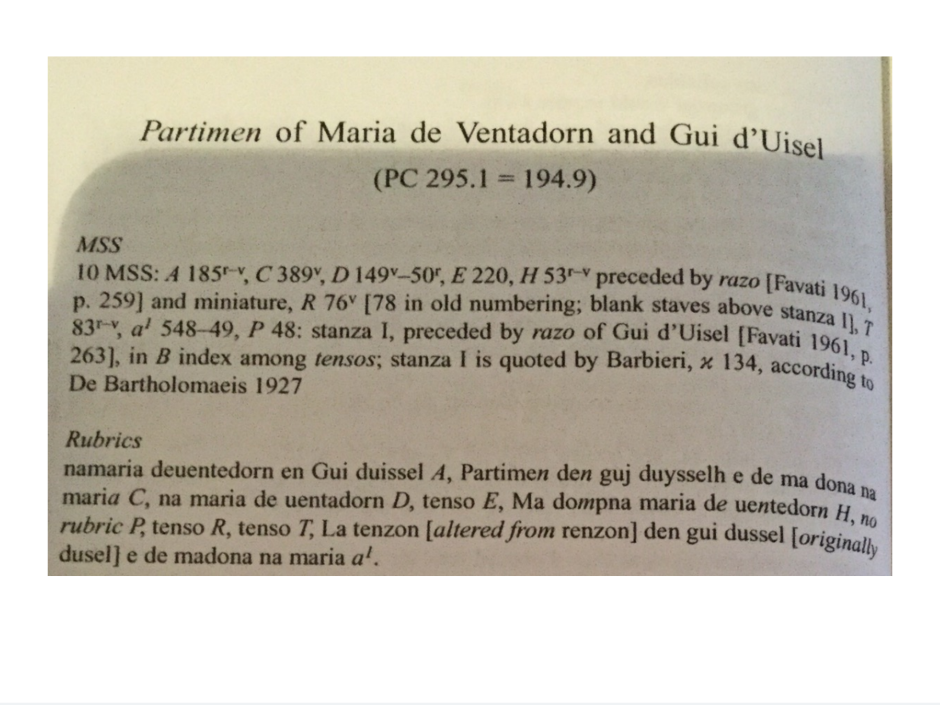
From Ruth Harvey & Linda Paterson, The Troubadour Tensos and Partimens: A Critical Edition (Cambridge: D.S. Brewer, 2010)
This is a reading of another Gui d’Ussel partimen [the first paper in this session having been on the Gui & Elias d’Ussel double partimen] this time with Maria de Ventadorn, that starts out: “Gui d’Uicel, be.m peza de vos” (PC 295.1=194.9; c.1196-98). Maria asks whether a lady “ought to do equally for her lover as he ought for her” (Linda Paterson’s translation of ll. 5-7: deu far engualmen/dona per drut, quan lo.i quer franchamen/com el per leis).
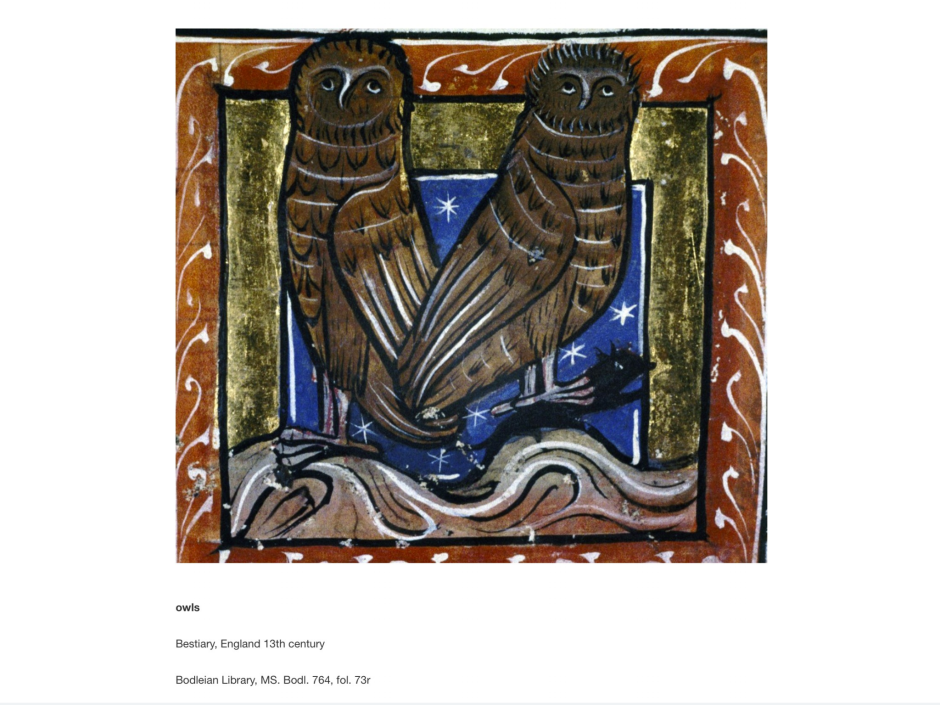
The dark forces of deceptive equality (with thanks to Matilda Tomaryn Bruckner for a reminder about the very different nature of medieval bestiary owls)
So. This will be a reading of a poem. Other poems will be involved. Further poems could be (there’s a short list at the end). Many other readings of this poem have been done (or “trobat”), and many more remain possible. This paper is also a story of a reading, weaving together three threads: the poem and some of its kith & kin, a reading, and what else happened in the time that’s passed between the ICLS call for papers and now.
I first read and worked on this poem in 2004, for other reasons. One was an idea of parity, and trying to think through differences between “equality” and “equity.” Another reason was “reason” itself: what razo means, including the idea of women having or exercising reason. The third was the phrase fals cor ni trichador, which echoed the fenera d’amor cortes in Flamenca. Some other key words caught my attention then and continue to do so now (though I now pretty much completely disagree with what my past self had to say). Here are the words and ideas:
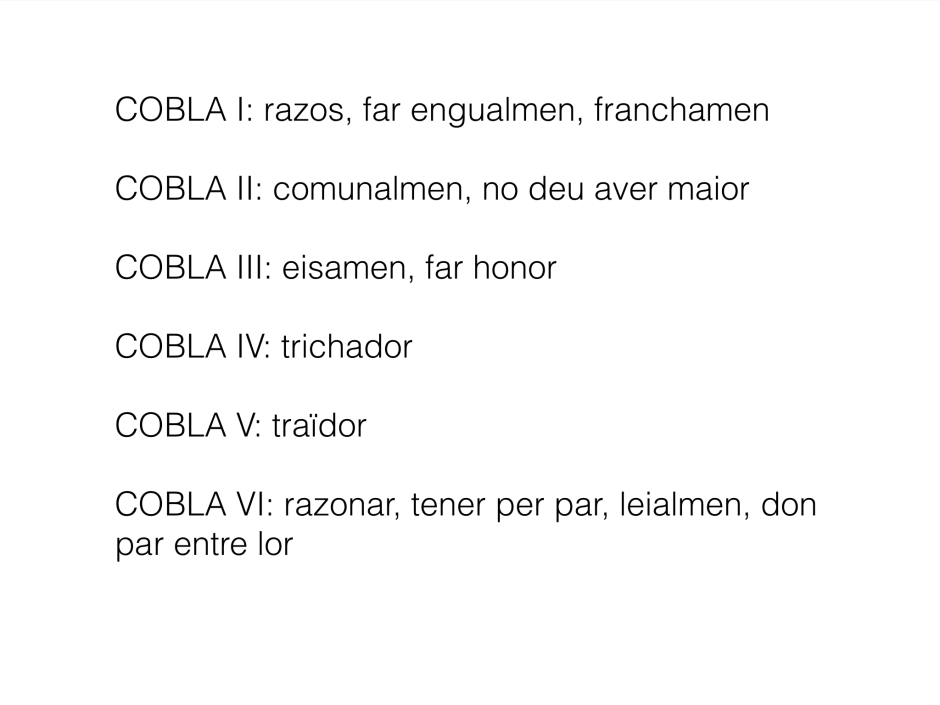
Shortly before I submitted my abstract for this conference, events in the real world cast a new light on this poem and some others to which it is thematically related. These events continued to haunt and reshape this reading. They occurred (and continue to occur) in many places, including most immediately at my home university and in my home city. We are talking about sexualised violence: harassment, assault, rape, and (if you even just do a quick Google search for “Highway of Tears”) murder.
In January 2016, faculty at UBC concerned about our university’s sexual assault policies, practices, and treatment of survivors wrote an open letter to our community:
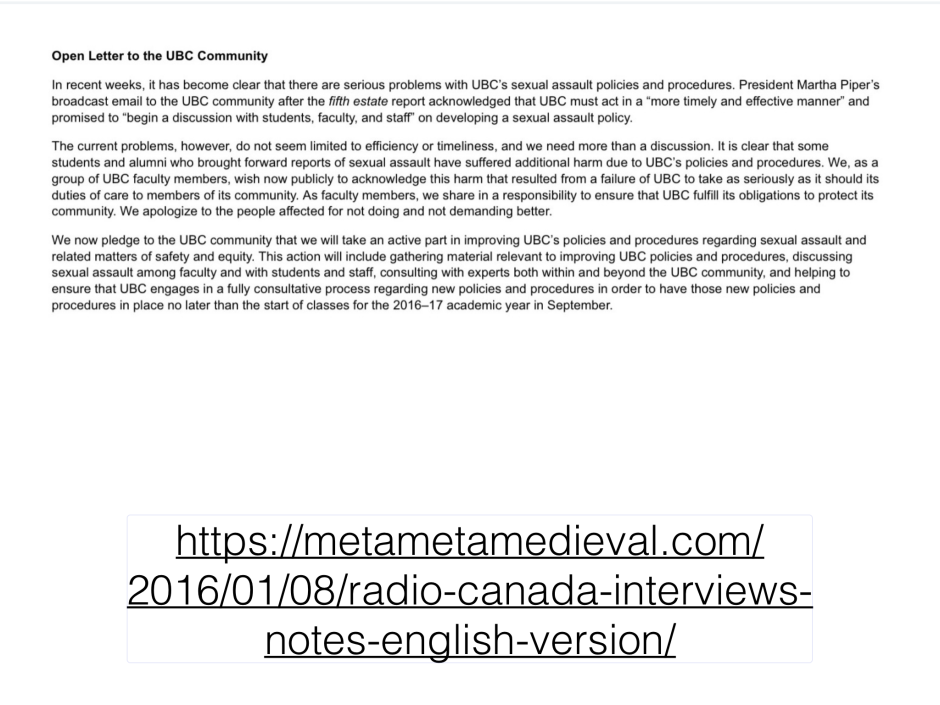
A fair amount of the last six months has been spent in meetings about what to do: as a member of a grassroots collective, of activists and advocates, critics and contributors, intermediaries (often feeling—and often feeling inappropriately amused by that feeling—very “marginal yet in the middle” as the sole medievalist and philologist, real live court jester), independents but friendly. Working with university and community groups. Working with lawyers, philosophers, therapists, and assorted theorists as well as practical people. Discussing prevention and education. As a continuing process in reshaping institutional culture, of finding new ways beyond and out of systemic support for and perpetration of problems.
Shaping, finding, all exercises in the craft of trobar.
One of the things that’s come out of this—and, alas, it’s not over and basically won’t be until people stop raping other people—and it may seem outré to claim that this deeply disturbing Recent period might have a silver lining—a positive, anyway, is that there are now more people in the world who know more about medieval literature and are aware of medieval Occitan courtly poetry, it’s doing good in the world, and we may have found a way for it to do more good and to bring consolation and beauty to yet more people. While fighting ignorance, misrepresentation, neocolonialist neomedievalism, and the War on Minds of the Real Dark Ages.
There are as many good minds around as there are ways to stay alive in resistance and resilience, and creative continuation: alter dicat, trobem sen e entendemen.
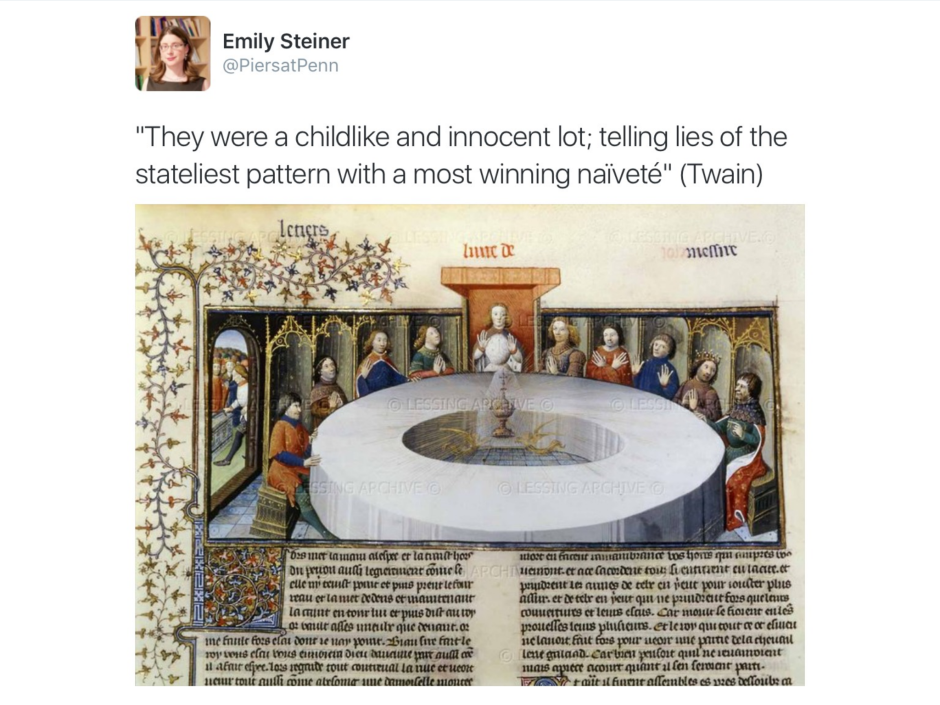
Here’s how.
COBLA I
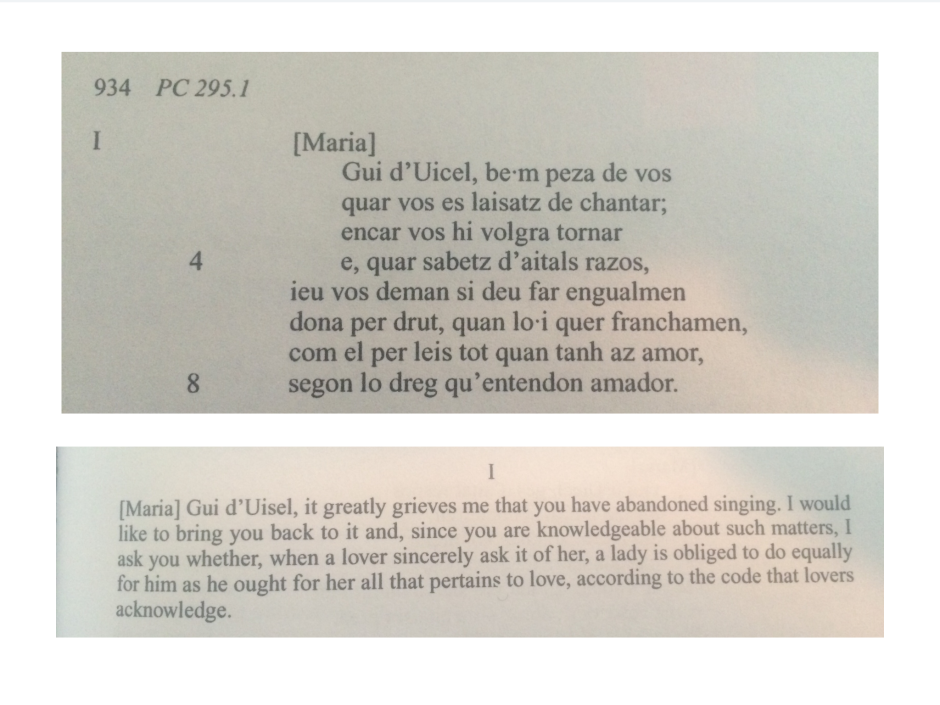
Harvey & Paterson
After a polite preamble, a question is asked. It is set up as a hypothetical matter; that could turn abstract or (as happens in other poems) turn later to adding further specifics, as one or more concrete cases for consideration. This is a courtly game in the fullest sense: the play-acting judici d’amors, echoing legal terminology and argumentation and form, and other kinds of debate including the scholarly. It’s also the kind of exercise that law students have been doing for generations; and that’s used in various sorts of training exercise. Here’s an example from April 2016, as used in UBC sexual assault panel consultation:
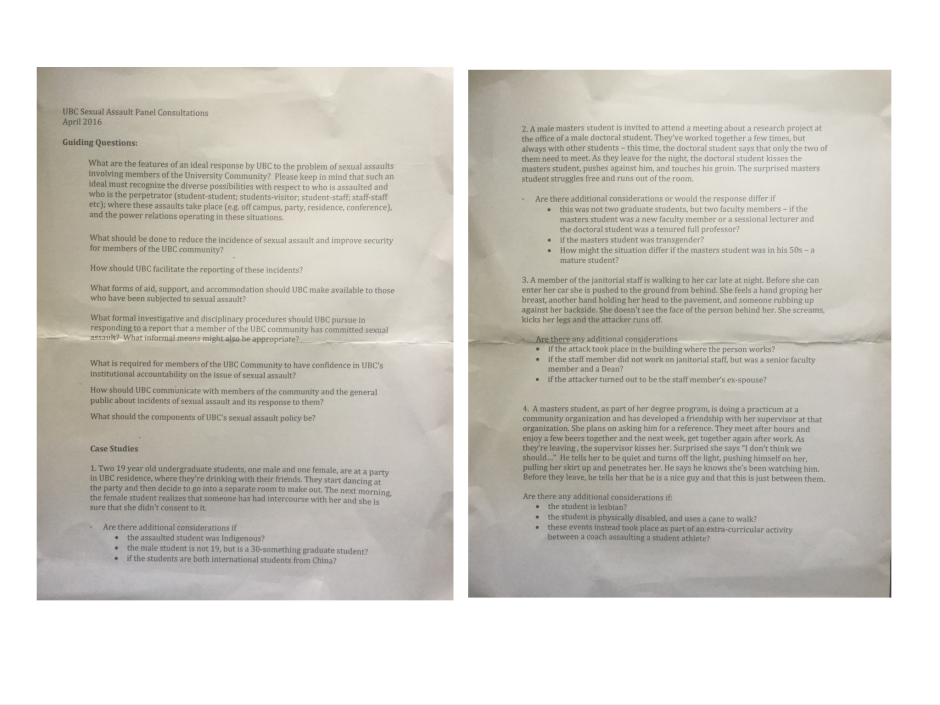
Case-studies—however close to or distant from real situations—and other exemplaria have of course also long been used for various didactic purposes: moving from the particular to the general and abstract. We’re laboriously trained, in the here and now, to be careful because when real lived experience intervenes, such discussions can move in the opposite direction, back to the very particular: triggering memories which can be triggering in the traumatic sense too. We can discuss trigger warnings later: suffice it to say that our partimen here contains several instances of triggering, for both participants. Whether sincere or artfully feigned is up to the reader’s judgement, just as it always has been and may it ever be so.
Those memories can flow productively into storytelling, and that can be helpful; healing rather than hurtful. See for further parallels any advice-column. Here’s another Occitan example, of advising between women:

From Matilda Tomaryn Bruckner, Laurie Shepard, and Sarah White, Songs of the Women Troubadours (New York: Garland, 1995)
Its irony and playfulness always surprises people to whom I’ve introduced trobador poetry for the first time.
This is a game with rules; that even playing-field is supposed to ensure parity and fairness. But there are ways of being cunning, devious, and adding twists (we’ll hear about more twists in Laura Zoll’s paper, next: on the delicious Pistoleta & Domna tenso, “Bona domna, un conseill vos deman”).

Our partimen starts out with a twist: Maria’s choice of rhyme and metre (abbaccdd os ar en or & 8×4 then 10×4) and laisatz de chantar poke fun at an earlier Gui misogynist poem
which in turn riffed on an earlier mala canso, also about leaving a bad woman
making that peza de vos and sabetz look rather less sympathetic and flattering. If the subject-matter of love-lyric is often simultaneously multiple, here the “abandoning of song” is at least a double-entendre and that question is not as innocent, neutral, or abstract as it might superficially seem. Here are some comparisons:
(Observe: dramatic and comic build-up around poder, satisfying & doing duty, service performed, the expression of gratitude on one’s knees (see also Flamenca), and impotence.
COBLA II
But there is a catch
and with it the possibility of upping the ante (and the snark): the second participant gets to choose what position they will take up in the debate.
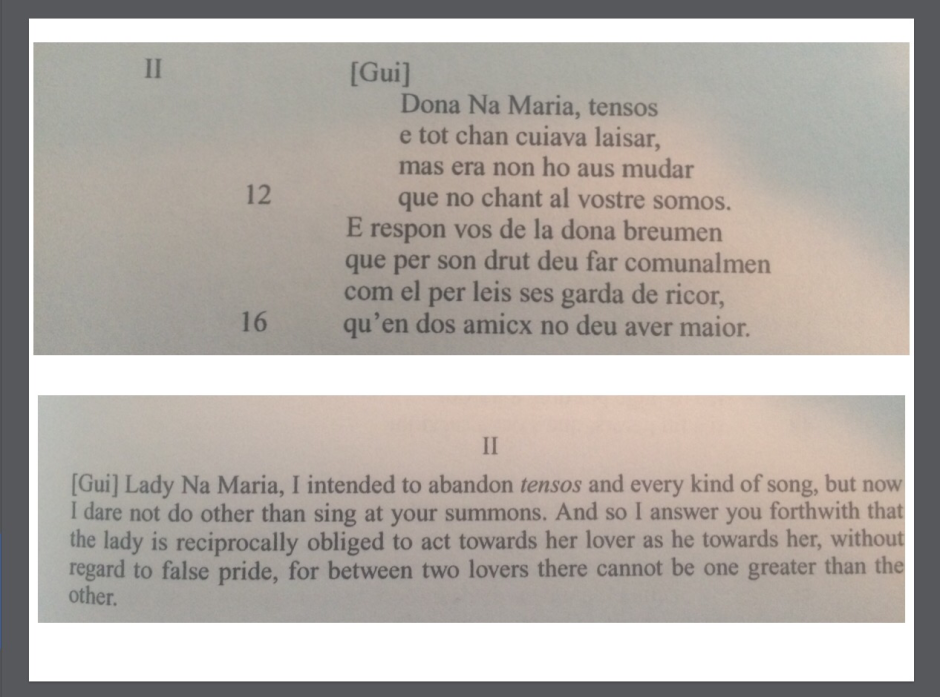
They might choose to adopt a role that doesn’t “come naturally,” or that might surprise their interlocutor, or the audience. A role that might be an intellectual and imaginative challenge. This could also dissipate tensions—for there is often at least a whiff of sexual tension in the tenso—and defuse potentially explosive situations.
Such role-play will look familiar from training of all sorts, yes the heinous sort that academics suffer (albeit being martyred by les supplices administratifs is technically a “passion”), but also to be found in improvisational comedy, self-defence, martial arts; in the culinary arts; and in what’s known variously as ally, bystander, or witness training in preventing harassment and assault; as also used by the police and other emergency services. Many more examples will doubtless come to your minds. Being prepared, through having previously imagined and acted out a scenario and all its possible outcomes and having seen it from angles, helps to prepare for an actual event.
Here in our poem, Gui twists back. Forced to do something, against his own will, in obedience to the will of another, he picks up on per drut and combines deu far engualmen with quer franchamen / com el per leis, turning them into deu far comunalmen / com el per leis and no deu aver maior: an argument that may look familier to anyone who’s ever crossed any men’s rights activists or “All Lives Matter” fans of the false equality of privilege. That sort of equality would of course mean that Maria and her like would no longer be in a position to ask such questions and expect a response; no more service; arguably, an end to courtesy and in its place an extreme franchamen.
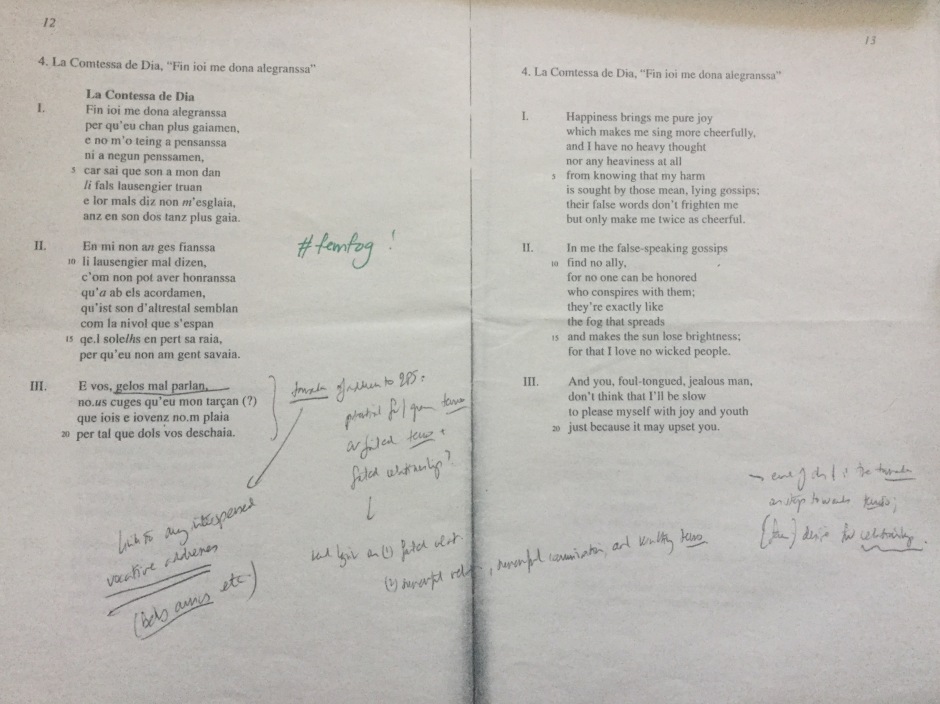
COBLA III
Maria sees the dangers, might or might not be somewhat conciliatory (line 20 is a matter of debate across manuscripts and editions), and brings back three elements from her opening cobla that had been rejected or turned around by Gui (though you could argue that she asked for it, by using tornar herself in the first place).
Repeated d-s multiply and underline their antecedents: dona, deu, drutz, while demandar reins Gui back to the original question. Could there be an intertextual worry about setting off another double partimen?
Cobla I’s com el per leis changes to com per amigua, and II’s deu far comunalmen (for the lady to do) turns to deu far precz e comandamen (for the gent) and far honor (for the lady). Combine the legal and argumentative loadings of these terms, and you have a proto-agreement of what in 2016 gets called consent and respect.
Add in an elephant in the room: there can be no equality while one party is physically stronger and more capable of violence than the other. That would be where no com a senhor comes in. A parallel, to show how those ideas of consent come together with a fear of violence, of a problematic extension of franchamen into ardimen (which is another reason why I’m wary of people abusing the word “passion”):
(Observe understanding and consent at work: consen echoing conten, framed by ardimen, its repetition by G turned around by rhyming with defen to lead into a witty last line about self-defence.)
COBLA IV
In the 2nd through 4th lines of the cobla, Gui redeploys words and sounds borrowed entirely from Maria’s opening cobla: framed by a replique to her be.m peza de vos in his sai dizem entre nos. Tête à tête, fausse confidence, sincerity, an entre nos that’s distinguishing two courtly cultures—in his home and in hers—or a “nos” that is “us lads” and delineating a clash of courtly cultures, divided by gender?
When Gui adopted the pose of a victim of force, long-abused, he played a stereotypically feminine relationship role, which could be imaginatively open-minded and welcoming; empathetic; casting light on domestic violence and bringing it out into the open; comic; a caricature; cruelly mocking; misanthropically generally satirical; misogynist; or all of the above. Not unlike classic manipulative Ovidiana, La Vieille in the Roman de la Rose , and her entremetteuse antecedents.
But there was always a seething anger, a potential for violent outburst, in undercurrent. Formal restrictions—the rules of the poetic game—kept that in check. Com and its sense of “with-ness” have gone: replaced by fals cor and cubrir. The second half of the cobla is entirely new material and, again, has a line that varies significantly across manuscripts and editions: which one is the trichador, or are they both? Either way, we’re out of franchamen territory; and that last line ab bel semblan deu cubrir sa dolor manages the misogynist triple whammy of insensitivity to cruelty (be it emotional or physical abuse or both), having a hurt woman smile through her hurt and cover her bruises, and adding insult to injury have that be a further example of feminine falseness, the mala dona.
Here’s what that trichador might have done, as a breach of promise, which might explain why the combination of the dolor caused and no com a senhor in the previous cobla will cause quite a reaction in the next cobla. The missing step, glossed over and veiled with that cubrir, is overpowering and forcing against consent. What you are seeing here is a rape joke in slow motion, as it teeters and goes over the edge.
So: how would or could our should one react?
COBLA V
Maria insists on terms of consensual contractual agreement: al comensar, preiar, sierva, per dreg. The breach of promise and treachery is in having given oneself as a servant and then taken more, si.s fai parers. (This is where I disagree with past self: I didn’t get the difference between being peers and making oneself into a peer; think of Steerpike in Gormenghast.)
Picking up Gui’s lai on dona vol amar, Maria turns it from theoretical abstraction to concrete practical action by the lover, quan vol preiar, and to the lady’s willingness to be served, in embedded direct speech: “voillatz qu’ieu vos sierva humilmen / coma vostr’om” reminding us of the com el per leis earlier and with that humilmen—new sounds and terms in response to the novelty of that second half of cobla IV—highlighted by its frame of v-s. Bring together volition and consent, and for better or worse you may be reminded of…
…at least in its construction around voler and showing what active consent looks like.
Maria adds further new sounds to the poem: mas jonhtas e de genoillos, ieu lo jutge. Put that together with al comensar and we may be seeing two intertextual (and perhaps rather more interpersonal) digs at Gui, in a continuing long-running courtly game in which she has been called on as judge; including the double partimen between Gui and Elias d’Ussel [as disussed in the previous talk on this panel, by Mary Franklin Brown], which turned into a double partimen in its third cobla with a change of topic and versification. Gui looked in danger of doing so in this present partimen… and, better safe than sorry, Maria may be bringing matters to a close by passing judgement. Has this game gone on long enough? Have we reached the limits of its jokes? Have we now gone entirely simple-entendre and very real? How can it be ended?
COBLA VI
Our current final cobla (which might or might not be an intended end) does some work in conclusion: ben es plaitz vergonhos / az ops de dona razonar echoes the opening cobla‘s quar sabetz d’aitals razos. I, Gui, who have so much knowledge of these matters (and perhaps arguments, and perhaps the knowledge is very tongue-in-cheek and could be going over the line from poking fun into insulting); you, Maria, who are doing a bad job of reasoning on behalf of Woman (and perhaps you’re not a very good woman yourself, and maybe I, Gui, am doing better at that too). Gui takes the device of embedded direct speech (by a hypothetical lover) in cobla V and spins that into embedded indirect speech by a hypothetical Maria: putting words into her mouth, controlling her, transforming her in a twist on her own words in the first cobla: vos hi volgra tornar. That’s “equality” for you: you end up turned into a tornada, trapped in Gui’s fictionalised simplified cartoon puppet version.
But is this straight-up unreflecting misogyny, incapable of seeing things—–aitals razos— from another point of view? Or is it itself a caricature of misogyny? Preserving ambiguity to incite further debate after the poem and into the world?
I don’t have an answer to that question.
But I do have two clues.
CLUE THE FIRST
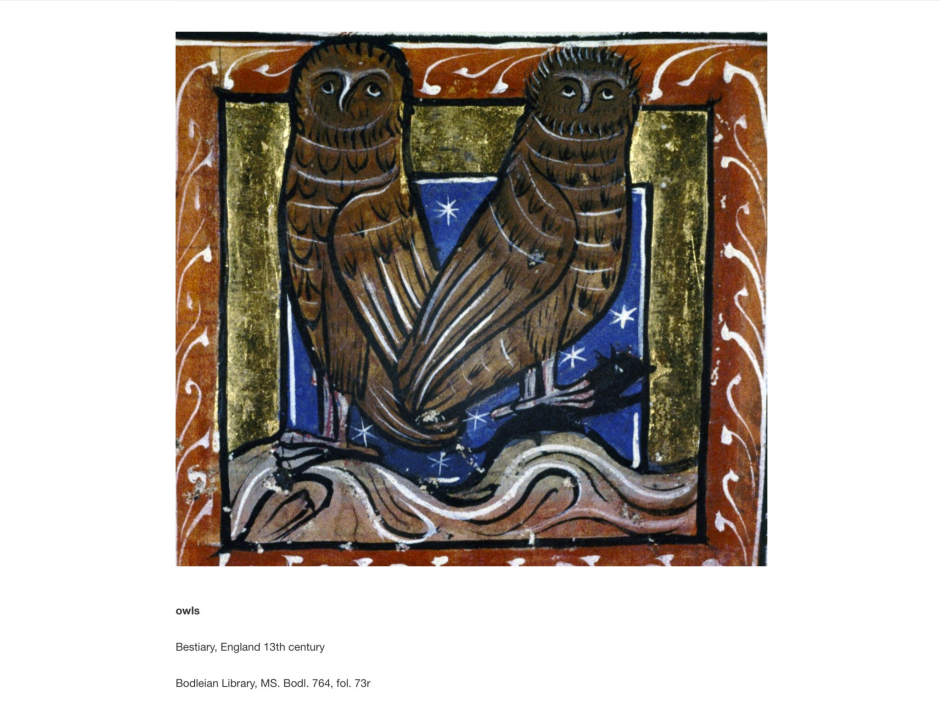
No.us estara gen: not being gen could bring two people together, into an ingenious entendemen of their own creation, in rejecting normative courtly values tainted by falseness in favour of franchamen and per amor. Together in truth, exclusive in exclusion. Subversive and marginal with respect to their other courtly milieu, the larger whole poetic corpus of which they are a part and with an ironic sense of its cohesive coherent wholeness as a culture of play.
[THIS SECTION WAS DEVELOPED FURTHER AFTER THE TALK:
Gen also echoes genoillos and gien: combine with a fag un cor de dos and the resulting image/sense is that of sexual activity that’s not PIV intercourse; could be seen as a more sophisticated, imaginative sort; and shows some interest by the kneeler in the standee’s pleasure. A Gui who is willing to play games of ingenious wit, speak in another language of love that is that of this foreign species, and slip into feminine wiles. Willing and able to compromise on stereotypical masculine expectations, and expectations that he would play a certain role and adopt its typical argumentative and other positions, in order to invent something more imaginative together. Willing to create a new language, with its in-jokes, a discours amoureux that is his and Maria’s alone.
Found and made, appropriately, in one of the ideal dialogic (and polyphonic) forms for such creative activity: tenso, partimen, roman.
(I do worry sometimes that I see too many kneeler/standee pairings in Occitan lyric, and in novas/romans like Flamenca. Perhaps this says more about me, and my rose-tinted glasses, than it says about the texts or that they say themselves. Bearing in mind a characteristic generalised lack of images in this literary corpus, though, perhaps it does still say something about the texts and a more imaginative literary and erotic culture. But I digress.) ]
CLUE THE SECOND
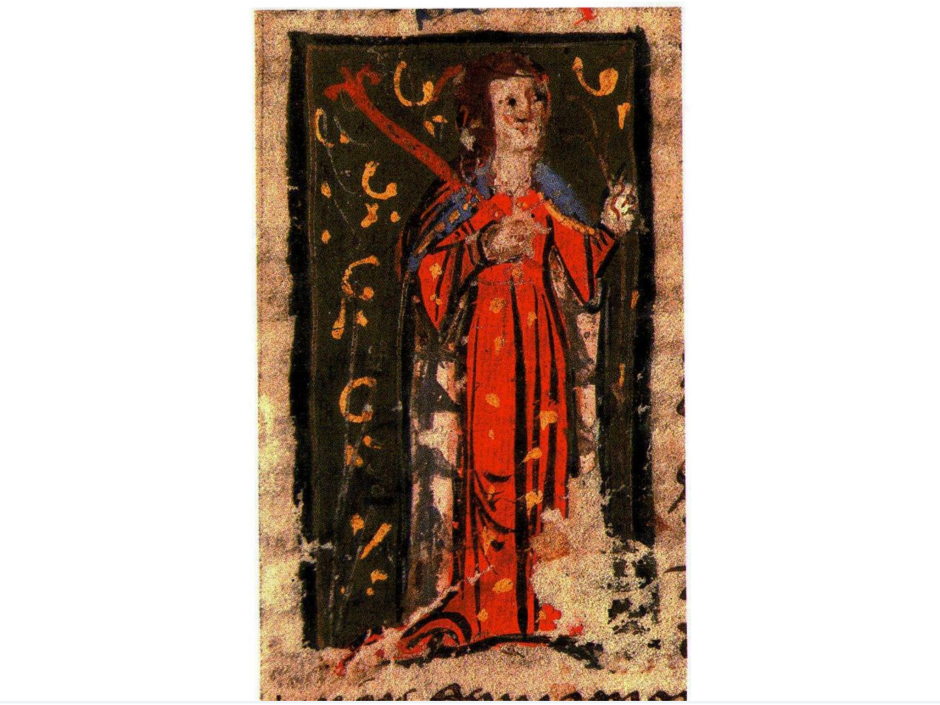
In one of the manuscripts. I think this is Maria de Ventadorn. I’ve not seen chansonnier H (MS Vat Lat 3207) and I’m guessing from piecing together descriptions. If this is her: if I recall from Beth Poe’s Compilatio: this is one of the trobairitz miniatures that is with the poem concerned, and the poem is amongst some male-authored lyric that’s not exactly flattering to women.
[POST-TALK: These things were later confirmed: thank you KC! Chansonnier H, MS Vat. Lat. 3207, f. 52v – 53r:]
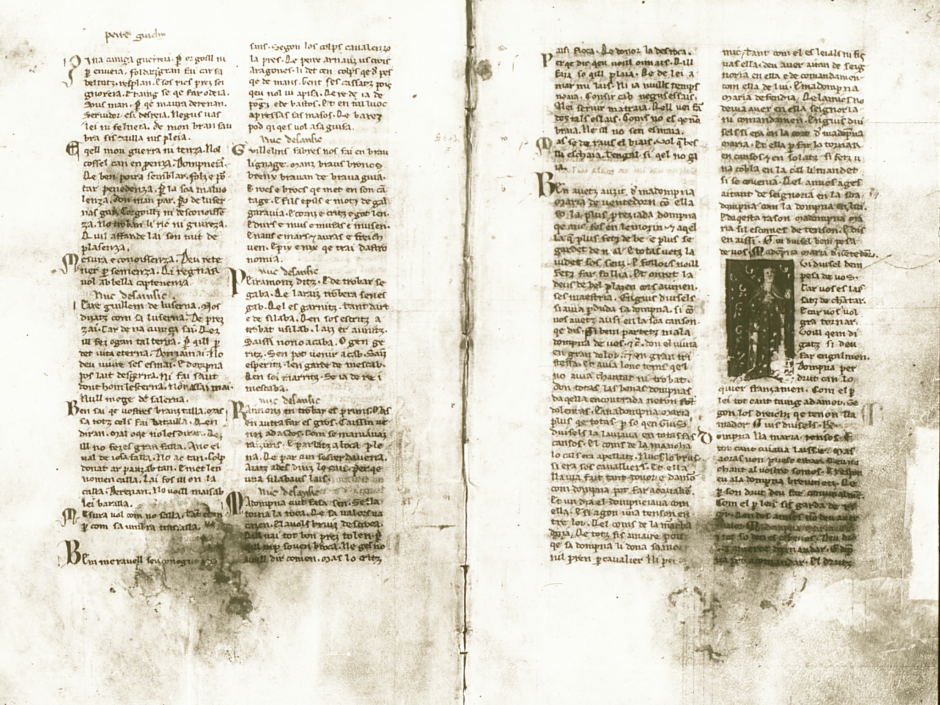
Interesting. Because this is not an unflattering or grotesque image, even if still friendly:
nor a caricature of awful feminine wiles
but perfectly respectable
Options for interpreting its placement in a more charitable light would include a reminder to readers that they’re dealing with real people, who can be hurt; a figure as an admonishment; more likely, given her hand-gesture, an indication that there might be another side to the matter in question, other interpretations; a reminder to readers to read intertextually, even also intratextually within the same manuscript / book; and it could be an incitement to debate, to continue poeticising, to continue questioning and playing with tensos and partimens outside the book, out here in the world.
I wonder how many readers, and how many audiences, learned about the joys of gen e gien from poems like this. My first practical experiment with it as live teaching material was back in January, when we had a virtual teach-in for sexual assault awareness (in response to some specific cases) and some of us also brought aitals rasos from our research areas into teaching. Tried and tested: formally debating some of these topics (Harvey & Paterson, from their excellent paratextual material; while there are other themes—I haven’t reproduced them all here below–“courting” and “sex” covers most of the corpus (as it were)):
Continue any unfinished-looking poem; this present partimen for example.
Play games with words, texts, arguments: keep razonar alive as a living art.
(Bring this poetry to life and into the lives of others today: this is a moral, social, and political duty of a responsible medievalist as this poetry could—as part of imaginative exercises and defences—could prevent violence, defuse it into talk and a more positive creative direction, offer people a chance to think before acting and reacting, and potentially save lives.)
Bring trobar into the world.
